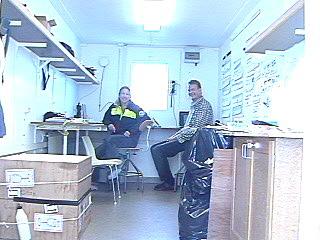
|
|
29 July, 2001
Heavy Ice Pack (HIP)
Sunday, 29 July 2001
Valkommen!
Life on Board
For the first two weeks of this expedition, I shared my container with the
light architect from Stockholm, Gerhard Rehm. In our container, he had a
computer, a printer, and some AutoCad-type drawings on the wall. That's
it. I usually had the container to myself because he often worked in other
places. At the Rotation in Svalbard on July 14th and 15th when some people
left the ship and new ones came onboard, he returned to Stockholm and I got
a new container mate. Also an artist from Stockholm, Johan Petterson
paints a different kind of light. He uses watercolor to capture images of
the Arctic while also being a keen observer of the people onboard. He uses
video and audio to record everything going on and seems constantly amazed
and amused by the idiosyncrasies of science and scientists. In our
container, in addition to his computer, one whole side of the container has
his art supplies and the whole wall is filled with color. I get to work in
the lightest and most colorful place on the ship! He is so genuinely
interested in people and their work that we have a constant stream of
visitors dropping by the container. Many just come by to chat. Many come
by just to look at the cartoon strips that he paints and posts. These
comic strips contain amusing tidbits of life on board that Johan is
parcticularly adept at picking out and everybody wants to see if they have
made it to the cartoon wall or just see what the latest buzz is all about.
This is the place to be.
Where Are We Now?
Apparently the seismic team found the gap they were looking for but it was
a bit of a disappointment, not being as deep or important as they hoped.
So, we are still working back and forth in a sampling grid pattern over the
ridge. They have posted HUGE printouts from the seismic mapping of a
nearby area from the 1996 Arctic Ocean Expedition on the Oden down on the
main level and they are amazing. You can tell on the readouts where the
sediment laid down on top of the ridge stops and the bedrock begins, as
well as other pockets of different densities down in the rock.
Scientists at Work
Most efforts today went into planning for the upcoming 20-day drift and ice
camp. This is going to be an incredible opportunity to collect good data
and follow different parameters over a fairly extended amount of time.
Several times at previous stations, some data was unusable due to effects
from the ship. These are unavoidable things like diesel fuel traces in the
water, paint fumes, and smokestack output. During the drift, the ship will
be shut down so there will be no contamination (and no MOTION!).
I learned how to stain bacteria today and make slides from the surface
microlayer samples that Johan Knulst collected at the last station. The
process is fairly involved with special filters and a DNA stain. Somehow,
I always manage to either drop or break cover slips for slides. I always
have, and probably always will, so I leave that crucial last step for
Johan.
Vi ses! (See you later!)
From Deck 4 on the Icebreaker Oden, still above the Lomonosov Ridge,
Dena Rosenberger

Johan Petterson and me, hard at work in the container.
Contact the TEA in the field at
.
If you cannot connect through your browser, copy the
TEA's e-mail address in the "To:" line of
your favorite e-mail package.
|
